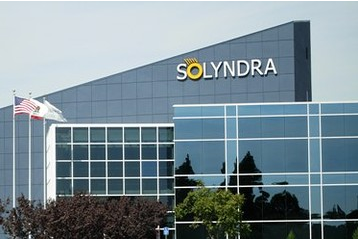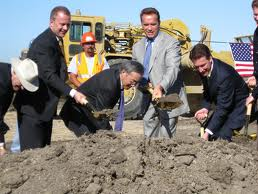We have much more to learn about the abrupt closing of Solyndra, the solar cell manufacturer in Fremont and its layoff of 1100 workers.
The story so far incorporates major themes of both the California economy and the U.S. economy, circa 2011: the impacts of globalization on the job structure in general and particularly in manufacturing; the politics of federal government investment; green jobs and the green economy. The Congressional hearing today on the Solyndra federal loan guarantee of $535 million should begin to yield answers.
What about Solyndra’s workforce? What are their likely employment futures in today’s economy? Can we get any guidance from the employment paths of the 4700 workers laid off in April 2010 from the nearby NUMMI plant?
 Solyndra closed on the morning of August 31, with no prior notice to its 1100 workers. The company filed a WARN notice, but only late on the 31st, after the closure.
Solyndra closed on the morning of August 31, with no prior notice to its 1100 workers. The company filed a WARN notice, but only late on the 31st, after the closure.
The California public workforce system over the past two decades has evolved considerably in its rapid response to large scale layoffs, as shown in the Solyndra response. Mr. Roy Bertuccelli, who manages mass layoffs and retraining at the Alameda County Workforce Investment Board (WIB) heard about the closing from KCBS radio. Within hours, the WIB staff was in the Solyndra parking lot distributing flyers about employment services available.
A first meeting was held last Friday at Ohlone College, and 160 former Solyndra workers attended. Individual employment sessions are starting for the workers, with an individual employment plan developed for each worker. The training or placement is tailored to each worker, based on skills and interests. Bertuccelli explains, “We encourage workers to recognize transferable skills they possess, and think of themselves as a combination of skills, not just one job.”
Bertuccelli has a long history with mass layoffs in Alameda County. He worked as an auto worker at the General Motors plant in Fremont and was laid off when the plant closed in the early 1980s. He’s seen the rise of NUMMI, taking over the plant, and then its closure in 2010, as well as the closures of most other heavy manufacturing in the East Bay. Tesla Motors has taken over the NUMMI plant, but so far it has created few jobs.
 The former NUMMI workers, as might be expected, have taken numerous paths since April 2010, though the Alameda WIB is still in the process of putting together its tracking data. Some have moved out of the area, in search of manufacturing jobs no longer in the Bay Area. Around 3400 of the 4700 workers did sign up for employment services with the WIB, and 1700 have participated in some form of training. The training has ranged from one month trucking skills training to a two year engineering project management certificate program with nearby Cal State University East Bay.
The former NUMMI workers, as might be expected, have taken numerous paths since April 2010, though the Alameda WIB is still in the process of putting together its tracking data. Some have moved out of the area, in search of manufacturing jobs no longer in the Bay Area. Around 3400 of the 4700 workers did sign up for employment services with the WIB, and 1700 have participated in some form of training. The training has ranged from one month trucking skills training to a two year engineering project management certificate program with nearby Cal State University East Bay.
The training has largely been individual training slots in such occupations as Pharmacy Technician and Welder, though the WIB also has purchased classes for 20 or so workers at Chabot College in Auto Mechanics, and Machine Operator training. On-the job contracts (up to $5000 reimbursement) have been undertaken with a range of firms in waste management, roofing, fine chocolates, and baking.
For the Solyndra workers, the job prospects initially look much better than for the NUMMI workers. Bertuccelli reports that in contrast to NUMMI, whose closure elicited no local employer response, more than ten employers in the area and nearby Silicon Valley have called asking about availability of Solyndra workers. The Solyndra workers come to the job market generally with more marketable skills, particularly in technology, than the NUMMI workers, and more experience in job search.
Still, with the unemployment rate in Santa Clara County at 10.3% and Alameda County at 11%, neither WIB staff nor Solyndra workers are complacent. The WIBs of Silicon Valley in July completed a study of technology hiring, “Silicon Valley in Transition: Economic and Workforce Implications in the Age of iPads, Android Apps, and the Social Web”, which warns that despite the Valley’s transition from recession to growth, employers can be choosey, requiring experience, knowledge of the most current technologies, and an ability to adapt and learn quickly. This poses a challenge for older, laid off technology workers, in competition with younger workers; and it poses a challenge for area workers in competition with highly skilled workers from around the nation and world.
As workforce practitioners throughout California know, no job placement, in any sector, even technology, is easy today.

